Typhoon Tracks Prediction with ConvLSTM Fused Reanalysis Data
Abstract
1. Introduction
2. Materials and Methods
2.1. Related Work
2.1.1. ConvLSTM
2.1.2. Canonical Correlation Analysis (CCA)
2.1.3. Grey Relation Analysis (GRA)
2.2. Datasets
2.2.1. Coordinates of the Typhoon’s Center
2.2.2. Reanalysis Data
2.2.3. Data Processing
2.3. ConvLSTM Establishment and Prediction
2.3.1. Correlation Analysis of Reanalysis Data
2.3.2. ConvLSTM Establishment and Improvement
2.3.3. Prediction of Tracks’ Coordinates
3. Results
3.1. Experimental Environment
3.2. Evaluation Indicators of the Model
3.3. Experimental Results
3.4. Comparison with Other Methods
4. Discussion
5. Conclusions
Author Contributions
Funding
Conflicts of Interest
References
- Liu, D.; Pang, L.; Xie, B. Typhoon disaster in China: Prediction, prevention, and mitigation. Nat. Hazards 2009, 49, 421–436. [Google Scholar] [CrossRef]
- Liu, G.L.; Li, X.; Wang, J.; Kou, Y.; Wang, X. Research on the statistical characteristics of typhoon frequency. Ocean Eng. 2020, 209, 107489. [Google Scholar] [CrossRef]
- Takagi, H.; Esteban, M.; Shibayama, T.; Mikami, T.; Matsumaru, R.; De Leon, M.; Thao, N.; Oyama, T.; Nakamura, R. Track analysis, simulation, and field survey of the 2013 Typhoon Haiyan storm surge. J. Flood Risk Manag. 2017, 10, 42–52. [Google Scholar] [CrossRef]
- Hon, K. Tropical cyclone track prediction using a large-area WRF model at the Hong Kong Observatory. Trop. Cyclone Res. Rev. 2020, 9, 67–74. [Google Scholar] [CrossRef]
- Wang, S.W.; Cheng, D.H.; Li, J.; Ma, S. A numerical typhoon track prediction model and its application on the real-time operation. Mausam 2021, 48, 195–204. [Google Scholar] [CrossRef]
- Hsan, T.Z.; Sein, M.M. Combining Support Vector Machine and Polynomial Regressing to Predict Tropical Cyclone Track. In Proceedings of the IEEE 3rd Global Conference on Life Sciences and Technologies (IEEE LifeTech), Nara, Japan, 9–11 March 2021; IEEE: New York, NY, USA, 2021; pp. 220–221. [Google Scholar]
- Tan, J.K.; Chen, S.; Wang, J. Western North Pacific tropical cyclone track forecasts by a machine learning model. Stoch. Environ. Res. Risk Assess. 2021, 35, 1113–1126. [Google Scholar] [CrossRef]
- Chen, R.; Wang, X.; Zhang, W.; Zhu, X.; Li, A.; Yang, C. A hybrid CNN-LSTM model for typhoon formation forecasting. Geoinformatica 2019, 23, 375–396. [Google Scholar] [CrossRef]
- Gao, S.; Zhao, P.; Pan, B.; Li, Y.; Zhou, M.; Xu, J.; Zhong, S.; Shi, Z. A nowcasting model for the prediction of typhoon tracks based on a long short term memory neural network. Acta Oceanol. Sin. 2018, 37, 8–12. [Google Scholar] [CrossRef]
- Rüttgers, M.; Lee, S.; Jeon, S.; You, D. Prediction of a typhoon track using a generative adversarial network and satellite images. Sci. Rep. 2019, 9, 1–15. [Google Scholar] [CrossRef]
- Kim, S.; Kim, H.; Lee, J.; Yoon, S.; Kahou, S.E.; Kashinath, K.; Prabhat, M. Deep-hurricane-tracker: Tracking and forecasting extreme climate events. In Proceedings of the 19th IEEE Winter Conference on Applications of Computer Vision (WACV), Waikoloa Village, HI, USA, 7–11 January 2019; IEEE: New York, NY, USA, 2019; pp. 1761–1769. [Google Scholar]
- Hong, S.; Kim, S.; Joh, M.; Song, S.K. GlobeNet: Convolutional Neural Networks for Typhoon Eye Tracking from Remote Sensing Imagery. arXiv preprint 2017, arXiv:1708.03417. [Google Scholar]
- Dee, D.P.; Uppala, S.M.; Simmons, A.J.; Berrisford, P.; Poli, P.; Kobayashi, S.; Andrae, U.; Balmaseda, M.A.; Balsamo, G.; Bauer, P.; et al. The ERA-Interim reanalysis: Configuration and performance of the data assimilation system. Q. J. R. Meteorol. Soc. 2011, 137, 553–597. [Google Scholar] [CrossRef]
- Giffard-Roisin, S.; Yang, M.; Charpiat, G.; Bonfanti, C.K.; Kégl, B.; Monteleoni, C. Tropical Cyclone Track Forecasting Using Fused Deep Learning from Aligned Reanalysis Data. Front. Big Data 2020, 3, 1–13. [Google Scholar] [CrossRef]
- Lian, J.; Dong, P.P.; Zhang, Y.; Pan, J.; Liu, K. A Novel Data-Driven Tropical Cyclone Track Prediction Model Based on CNN and GRU with Multi-Dimensional Feature Selection. IEEE Access 2020, 8, 97114–97128. [Google Scholar] [CrossRef]
- Peng, J.; Qiao, R.L.; Liu, Y.; Blaschke, T.; Li, S.; Wu, J.; Xu, Z.; Liu, Q. A wavelet coherence approach to prioritizing influencing factors of land surface temperature and associated research scales. Remote Sens. Environ. 2020, 246, 111866. [Google Scholar] [CrossRef]
- Tan, R.P.; Zhang, W.D.; Chen, S. Decision-Making Method Based on Grey Relation Analysis and Trapezoidal Fuzzy Neutrosophic Numbers Under Double Incomplete Information and its Application in Typhoon Disaster Assessment. IEEE Access 2020, 8, 3606–3628. [Google Scholar] [CrossRef]
- Zheng, Z.; Zha, B.T.; Yuan, H.; Xuchen, Y. Edge Detection Algorithm based on Morphology and Grey Relation Analysis. In Proceedings of the 16th IEEE International Conference on Mechatronics and Automation (IEEE ICMA), Tianjin, China, 4–7 August 2019; IEEE: New York, NY, USA, 2019; pp. 945–950. [Google Scholar]
- Fekadu, K. Ethiopian Seasonal Rainfall Variability and Prediction Using Canonical Correlation Analysis (CCA). Earth Sci. 2015, 4, 112–119. [Google Scholar] [CrossRef]
- Moishin, M.; Deo, R.C.; Prasad, R.; Raj, N.; Abdulla, S. Designing Deep-Based Learning Flood Forecast Model with ConvLSTM Hybrid Algorithm. IEEE Access 2021, 9, 50982–50993. [Google Scholar] [CrossRef]
- Shi, X.J.; Chen, Z.R.; Wang, H.; Yeung, D.Y.; Wong, W.K.; Woo, W.C. Convolutional LSTM Network: A Machine Learning Approach for Precipitation Nowcasting. In Proceedings of the 29th Annual Conference on Neural Information Processing Systems (NIPS), Montreal, Canada, 7–12 December 2015; Neural Information Processing Systems (NIPS): La Jolla, CA, USA, 2015. [Google Scholar]
- Yang, X.H.; Liu, W.F.; Liu, W.; Tao, D. A Survey on Canonical Correlation Analysis. IEEE Trans. Knowl. Data Eng. 2021, 33, 2349–2368. [Google Scholar] [CrossRef]
- Li, Y.; Bin, G.Y.; Gao, X.; Hong, B.; Gao, S. Analysis of phase coding SSVEP based on canonical correlation analysis (CCA). In Proceedings of the 5th International IEEE Engineering-in-Medicine-and-Biology-Society (EMBS) Conference on Neural Engineering (NER), Cancun, Mexico, 27 April 27–1 May 2011; IEEE: New York, NY, USA, 2011; pp. 368–371. [Google Scholar]
- Tan, Y.J.; Zhou, W.G. Image Scrambling Degree Evaluation Algorithm Based on Grey Relation Analysis. In Proceedings of the 2010 International Conference on Computational and Information Sciences, Chengdu, China, 17–19 December 2010; IEEE: New York, NY, USA, 2010; pp. 511–514. [Google Scholar]
- Sallehuddin, R.; Shamsuddin, S.M.H.; Hashim, S.Z.M. Application of Grey Relational Analysis for Multivariate Time Series. In Proceedings of the 8th International Conference on Intelligent Systems Design and Applications (ISDA 2008), Kaohsiung, Taiwan, 26–28 November 2008; IEEE: New York, NY, USA, 2008; pp. 432–437. [Google Scholar]
- Kitamoto, A. Digital Typhoon: Near Real-Time Aggregation, Recombination and Delivery of Typhoon-Related Information. In Proceedings of the 4th International Symposium on Digital Earth (ISDE), Tokyo, Japan, 28–31 March 2005. [Google Scholar]
- Kitamoto, A. “Digital Typhoon” Typhoon Analysis based on Artificial Intelligence Approach. Tech. Rep. Inf. Processing Soc. Jpn. IPSJ 2000, CVIM123-8, 59–66. [Google Scholar]
- Hersbach, H.; Bell, B.; Berrisford, P.; Hirahara, S.; Horányi, A.; Muñoz-Sabater, J.; Nicolas, J.; Peubey, C.; Radu, R.; Schepers, D.; et al. The ERA5 global reanalysis. Q. J. R. Meteorol. Soc. 2020, 146, 1999–2049. [Google Scholar] [CrossRef]
- Mahmoud, H.; Akkari, N. Shortest Path Calculation: A Comparative Study for Location-Based Recommender System. In Proceedings of the World Symposium on Computer Applications and Research (WSCAR), Cairo, Egypt, 12–14 March 2016; IEEE: New York, NY, USA, 2016; pp. 1–5. [Google Scholar]
- Kordmahalleh, M.M.; Sefidmazgi, M.G.; Homaifar, A. A Sparse Recurrent Neural Network for Trajectory Prediction of Atlantic Hurricanes. In Proceedings of the Genetic and Evolutionary Computation Conference (GECCO), Denver, CO, USA, 20–24 July 2016; Assoc Computing Machinery: New York, NY, USA, 2016; pp. 957–964. [Google Scholar]
- Chen, J.X. Forecast of Tropical Cyclone Track based on Shape Index and SVM. J. Meteorol. Res. Appl. 2010, 31, 61–64. [Google Scholar]
- Chaudhuri, S.; Dutta, D.; Goswami, S.; Middey, A. Track and intensity forecast of tropical cyclones over the North Indian Ocean with multilayer feed forward neural nets. Meteorol. Appl. 2015, 22, 563–575. [Google Scholar] [CrossRef]
- Tekin, S.F.; Ilhan, F. CS559 Project Report Forecasting of Tropical Cyclone Trajectories with Deep Learning. 2021. Available online: https://sftekin.github.io/pdfs/hurricane.pdf (accessed on 5 September 2022).
- Wu, Y.Q.; Geng, X.Y.; Goswami, S.; Middey, A. Tropical Cyclone Forecast Using Multitask Deep Learning Framework. IEEE Geosci. Remote Sens. Lett. 2022, 19, 1–5. [Google Scholar] [CrossRef]
- Kim, S.; Kang, J.S.; Lee, M.; Song, S.K. DeepTC: ConvLSTM Network for Trajectory Prediction of Tropical Cyclone using Spatiotemporal Atmospheric Simulation Data. In Proceedings of the 32nd Conference on Neural Information Processing Systems (NIPS 2018), Montréal, Canada, 3–8 December 2018; Neural Information Processing Systems (NIPS): La Jolla, CA, USA, 2018. [Google Scholar]
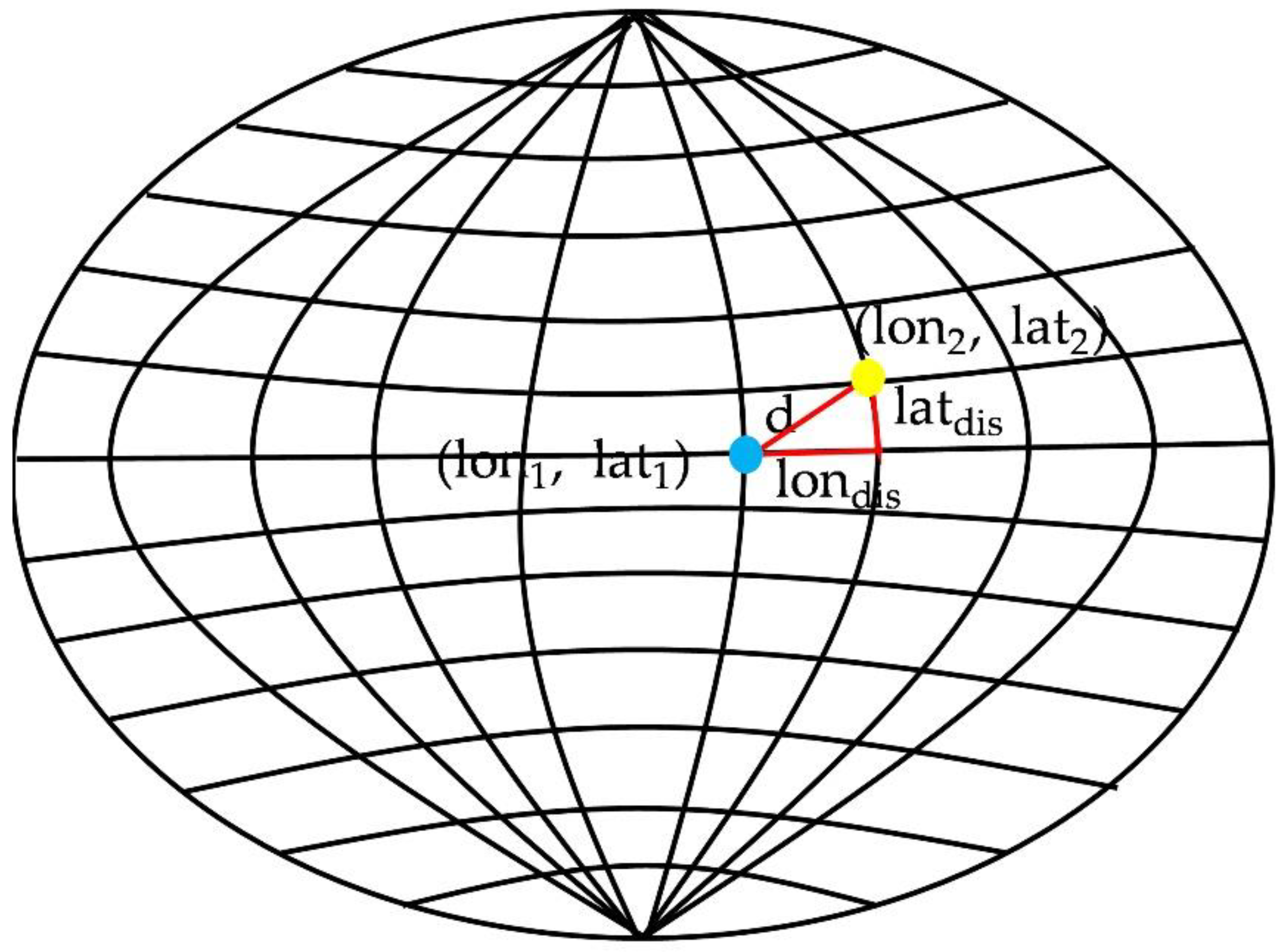
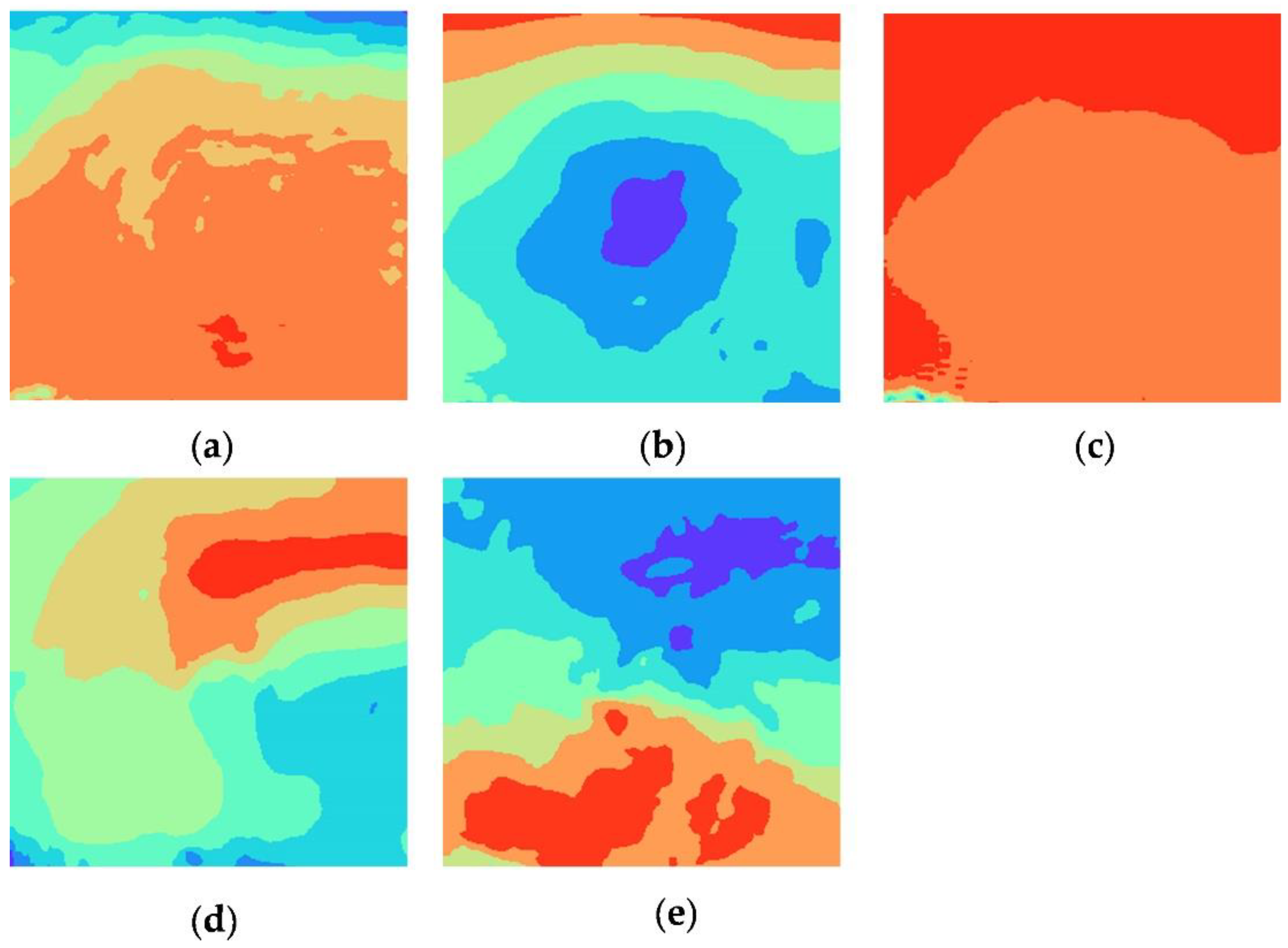
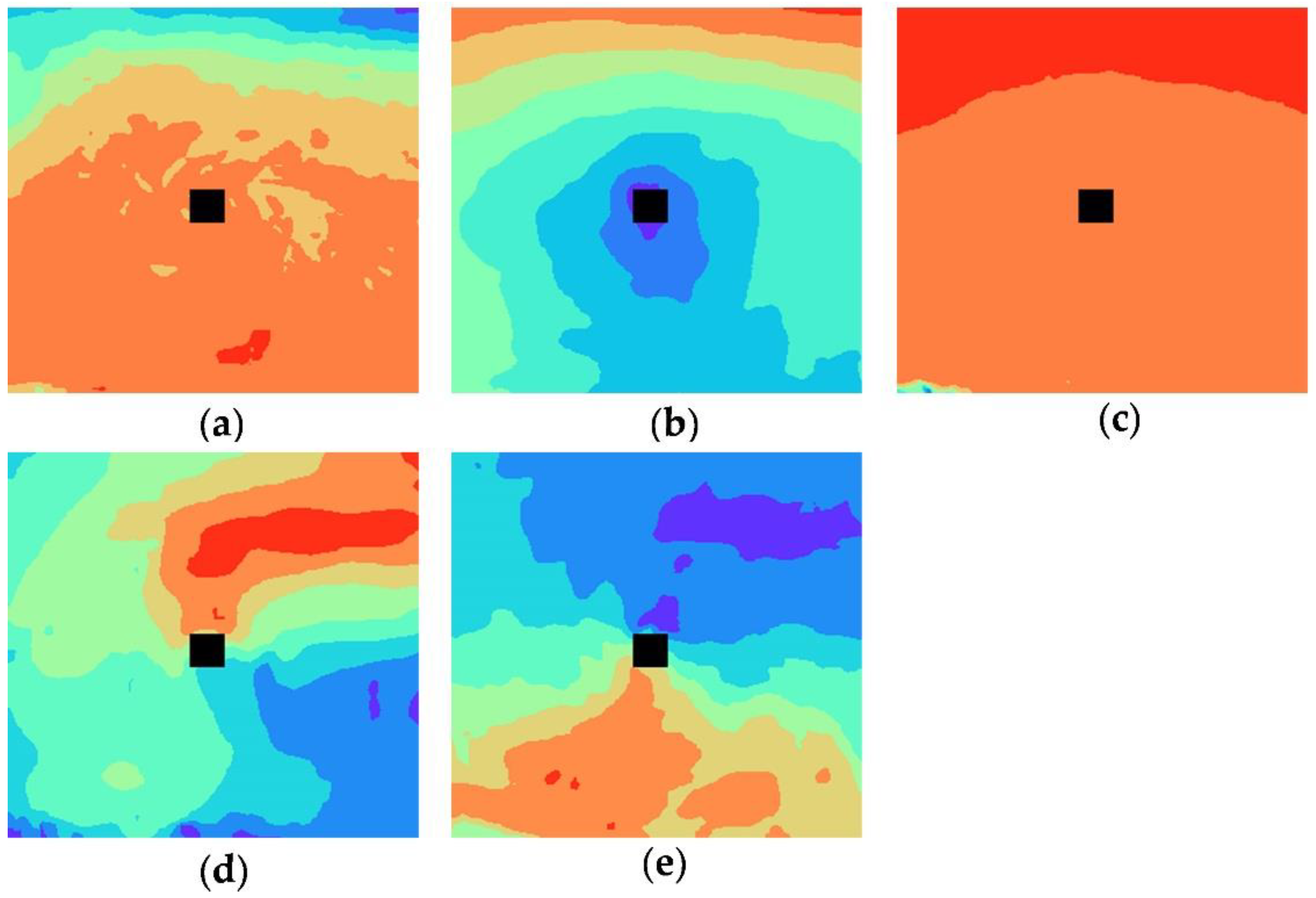
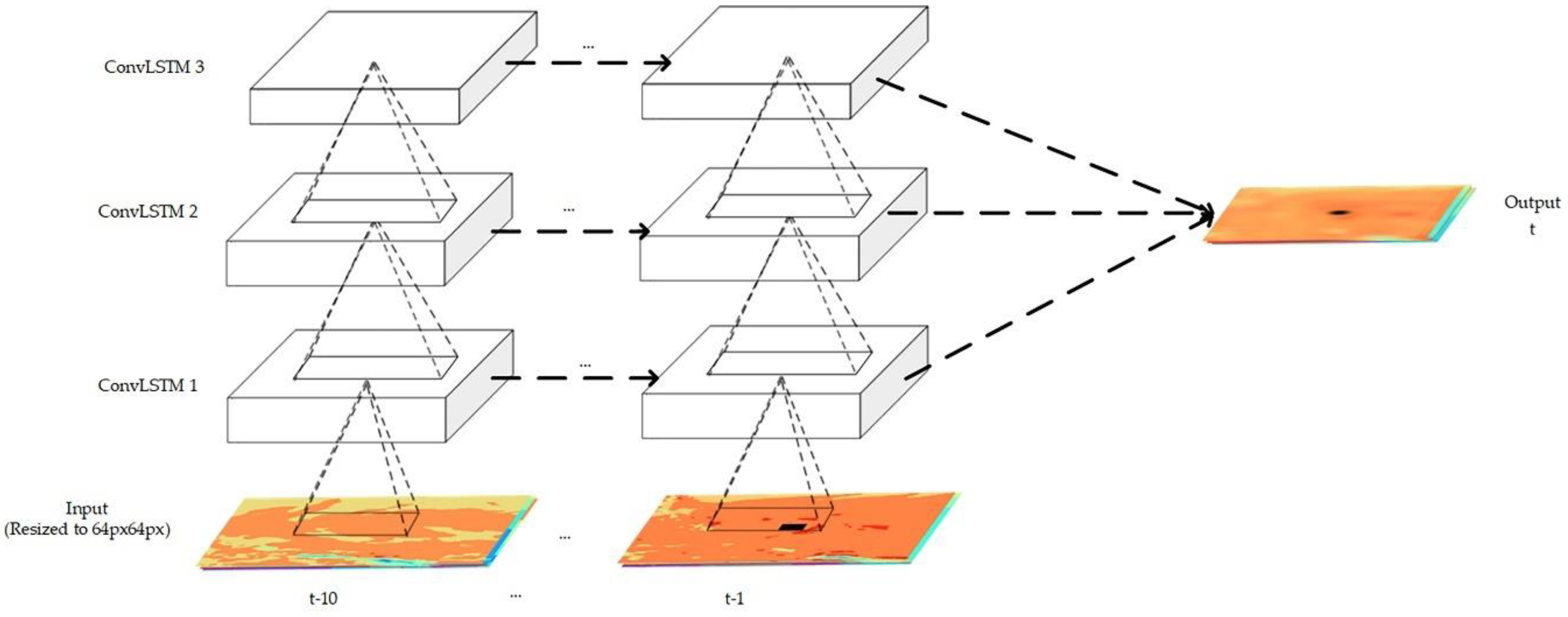

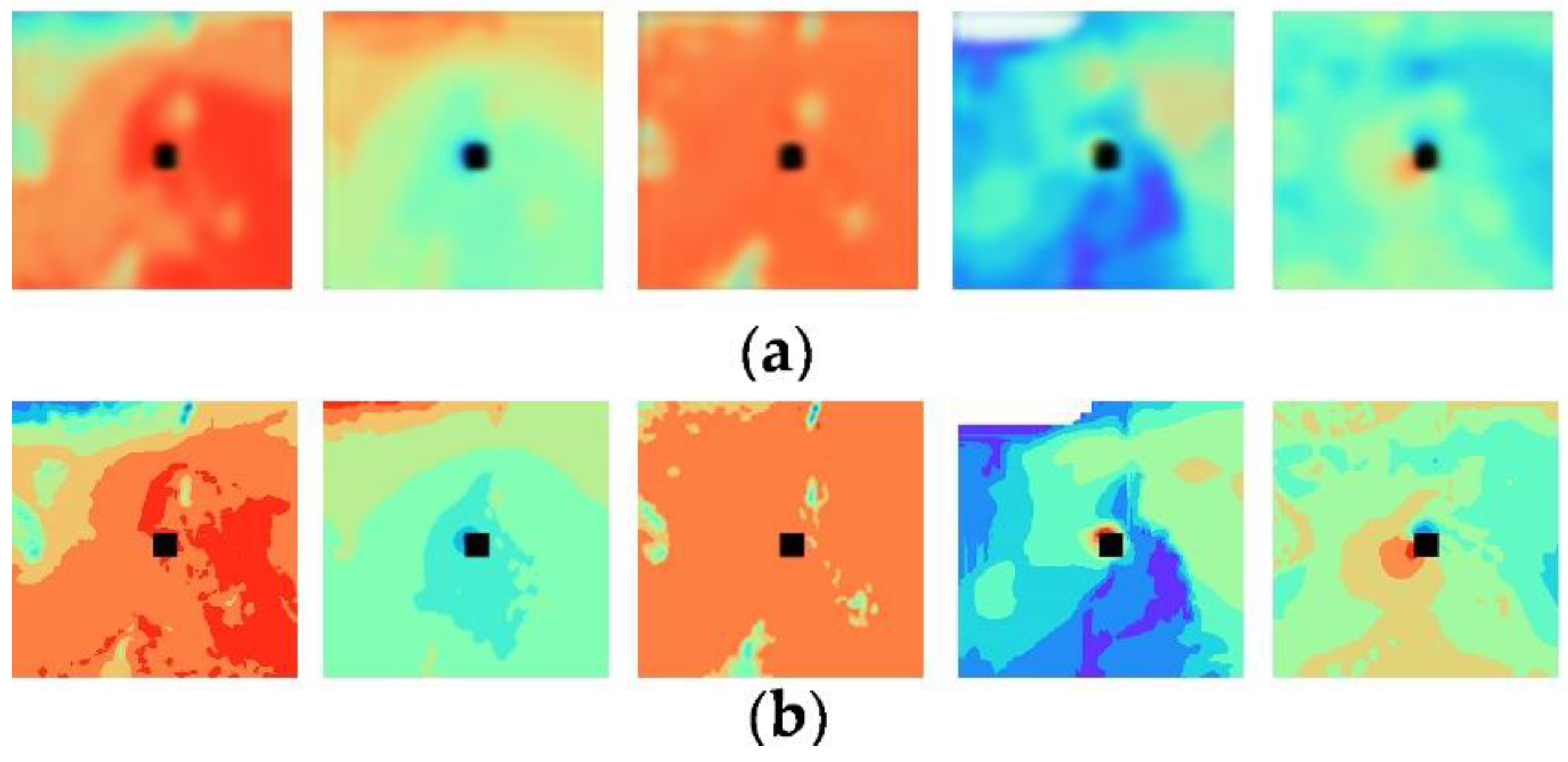
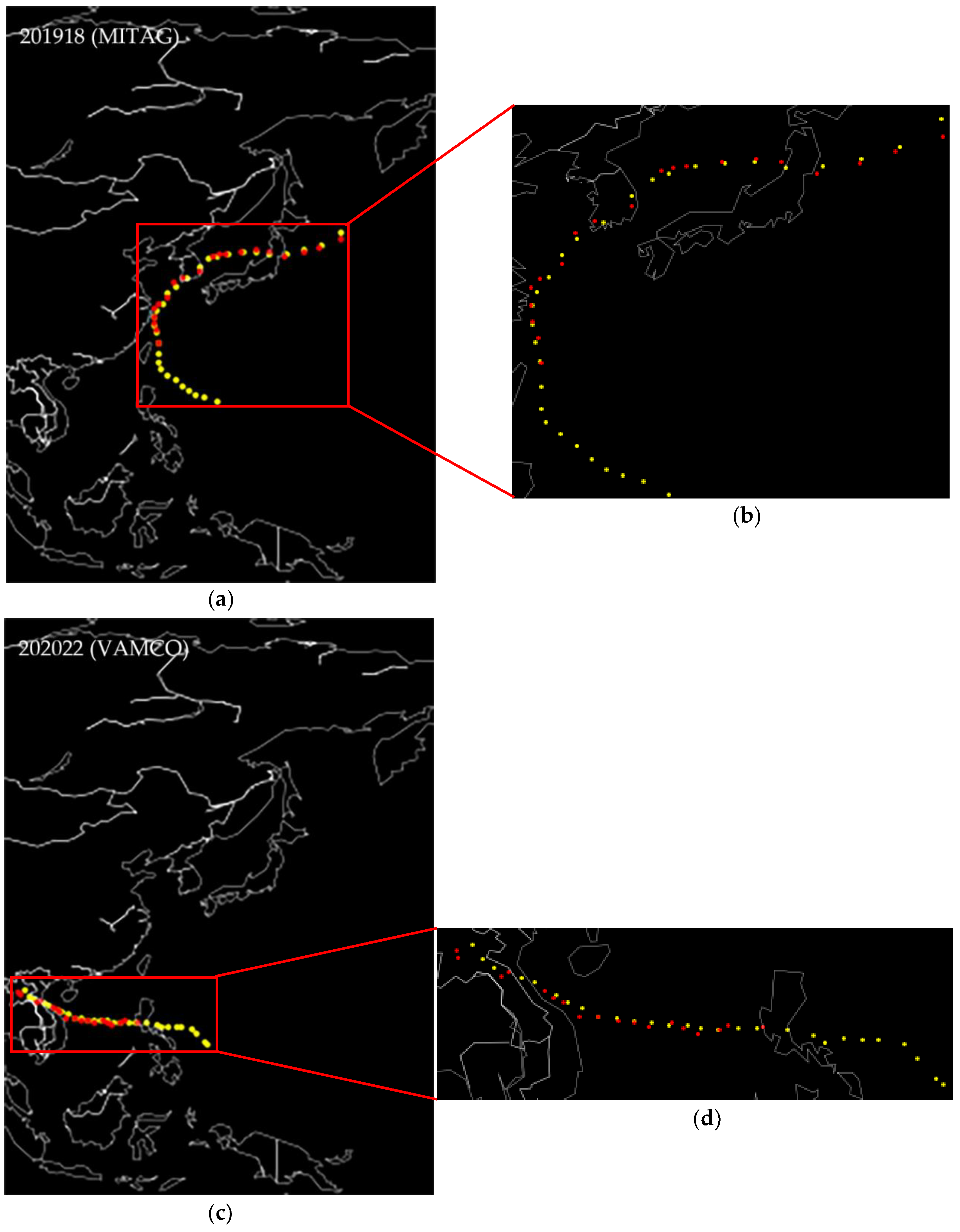
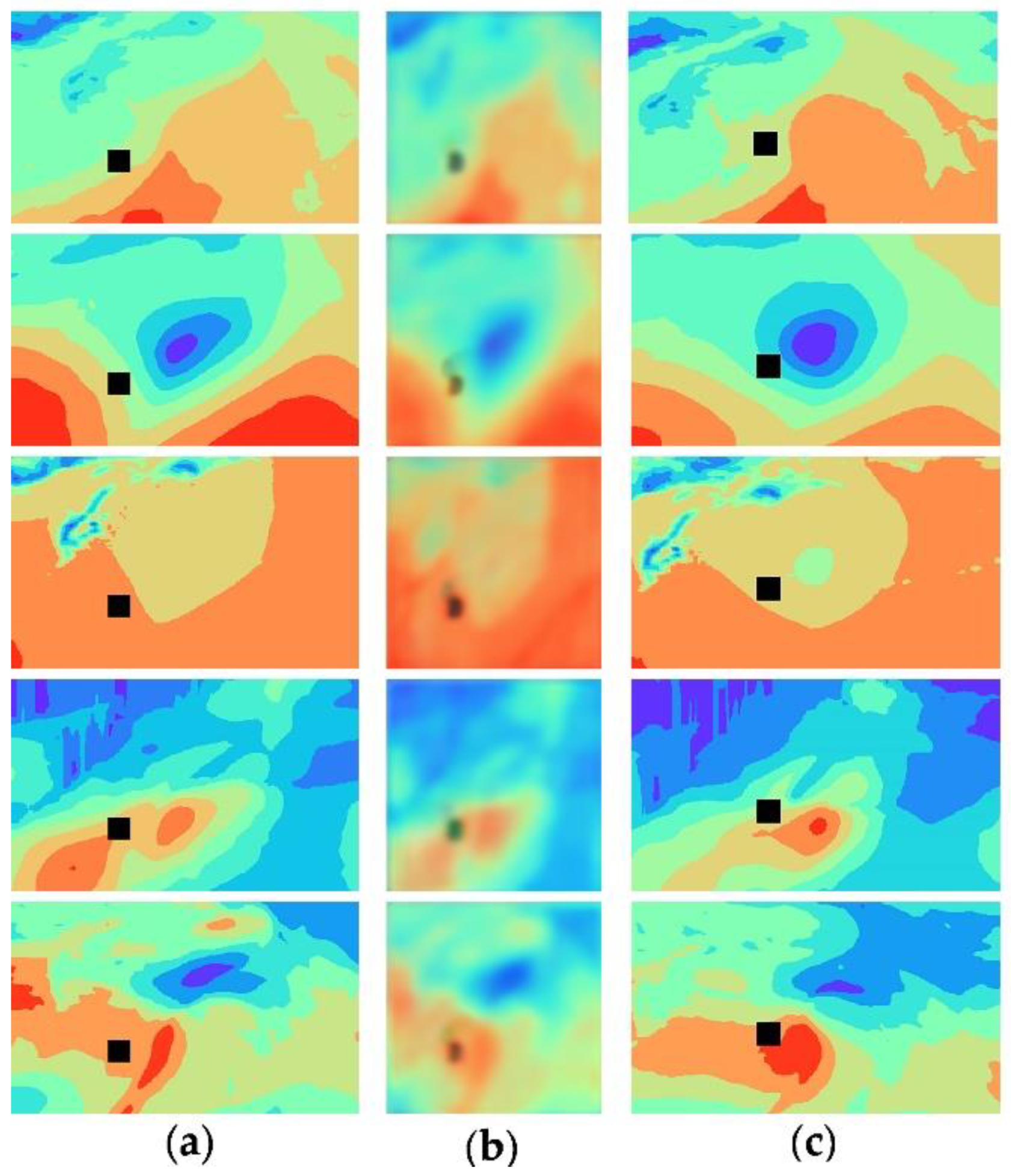
| Parameters | Values |
|---|---|
| Input dimension | (batch_size, 10, 15, 64, 64) |
| Kernel sizes | 3) |
| Number of Gate unit nodes | 15 |
| Number of layers | 3 |
| Parameters and Device Name | Values and Version |
|---|---|
| GPU | NVIDIA GeForce RTX 3060 |
| epoch | 50 |
| batch_size | 10 |
| learning rate | 0.001 |
| Models | MAE (km) | RMSE (km) | MAELAT | MAELON |
|---|---|---|---|---|
| Improved ConvLSTM | 54.69 | 71.27 | 0.303 | 0.393 |
| ConvLSTM model with only one convolutional ConvLSTM unit layer | 56.66 | 73.09 | 0.454 | 0.609 |
| Methods | MAE (km) | RMSE (km) | MAELAT | MAELON |
|---|---|---|---|---|
| Proposed method | 54.69 | 71.27 | 0.303 | 0.393 |
| Sparse RNN [30] | 72.11 | - | 0.549 | 0.299 |
| GAN [10] | 69.1 | - | - | - |
| Deep-Hurricane-Tracker: ConvLSTM [11] | - | 140.97 | - | - |
| SVM [31] | 57.6 | - | - | - |
| NNA 1 [32] | 55 | - | - | - |
| TrajGRU [33] | 66.6 | - | - | - |
| WCycleGAN + TCLNet [34] | 61 | - | - | - |
| DeepTC: ConvLSTM [35] | - | - | 1.8 | 2.12 |
Publisher’s Note: MDPI stays neutral with regard to jurisdictional claims in published maps and institutional affiliations. |
© 2022 by the authors. Licensee MDPI, Basel, Switzerland. This article is an open access article distributed under the terms and conditions of the Creative Commons Attribution (CC BY) license (https://creativecommons.org/licenses/by/4.0/).
Share and Cite
Lu, P.; Xu, M.; Sun, A.; Wang, Z.; Zheng, Z. Typhoon Tracks Prediction with ConvLSTM Fused Reanalysis Data. Electronics 2022, 11, 3279. https://doi.org/10.3390/electronics11203279
Lu P, Xu M, Sun A, Wang Z, Zheng Z. Typhoon Tracks Prediction with ConvLSTM Fused Reanalysis Data. Electronics. 2022; 11(20):3279. https://doi.org/10.3390/electronics11203279
Chicago/Turabian StyleLu, Peng, Mingyu Xu, Ao Sun, Zhenhua Wang, and Zongsheng Zheng. 2022. "Typhoon Tracks Prediction with ConvLSTM Fused Reanalysis Data" Electronics 11, no. 20: 3279. https://doi.org/10.3390/electronics11203279
APA StyleLu, P., Xu, M., Sun, A., Wang, Z., & Zheng, Z. (2022). Typhoon Tracks Prediction with ConvLSTM Fused Reanalysis Data. Electronics, 11(20), 3279. https://doi.org/10.3390/electronics11203279









